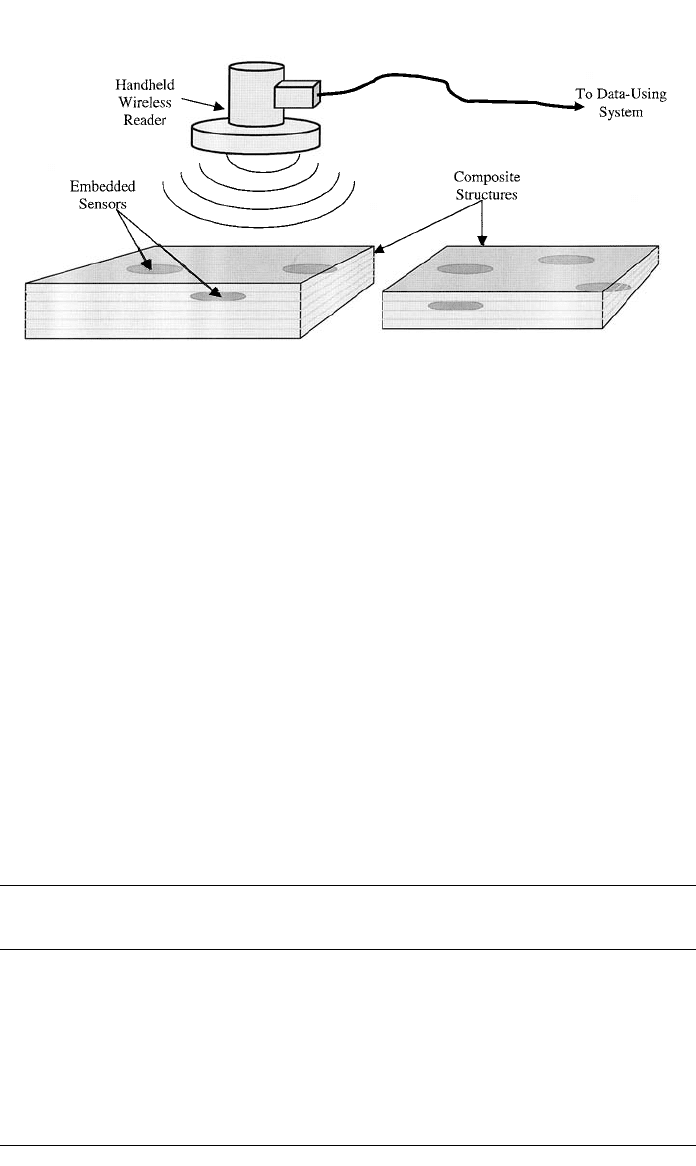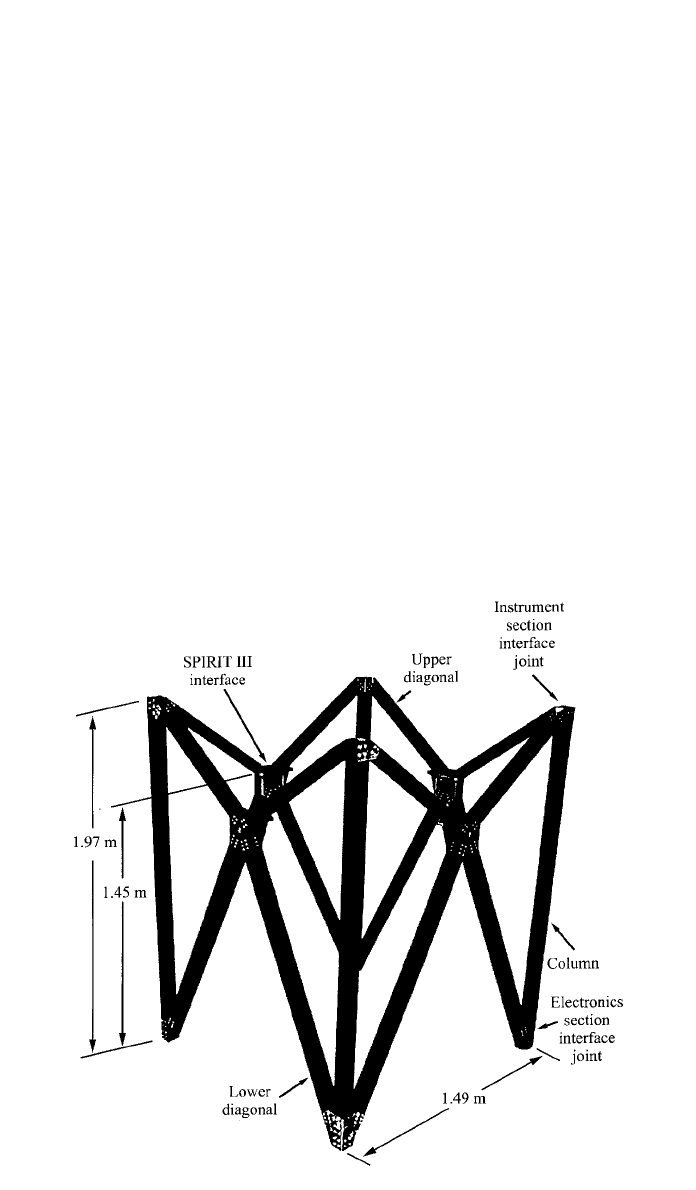Kutz M. Handbook of materials selection
Подождите немного. Документ загружается.


1148 SPACECRAFT APPLICATIONS OF ADVANCED COMPOSITE MATERIALS
sors (strain gauges, optical-fiber-based grating sensors, etc.) on these materials
due to difficulties in placing the sensor and maintaining the connecting wire or
fiber during composite fabrication. For wired sensors, the connection requires
slits or holes in the layers, or it must extend across the layer to the edge of the
lay-up. Either method is tedious to produce and introduces flaws or potential
flaws into the composite material, because structural integrity is compromised.
Flaws can be minimized through the use of very fine wires, but they are delicate
and often break during lay-up, which is also a problem in the use of optical
fiber. To avoid these difficulties, the U.S. Office of Naval Research (ONR)
funded development programs for wireless sensors that can be powered and
queried without physical connections.
ONR had several high-level requirements for the ARRQEM sensor system.
The primary requirement was the measurement of various physical phenomena
(e.g., strain, pressure, temperature) within a composite structure. Other require-
ments included:
●
Low recurring cost (including installation costs and the use of consumable
components such as sensors)
●
Usable lifetime commensurate with the instrumented structure (50 years
in some cases)
●
Interrogation possible from a minimum distance of several inches without
physical contact
●
Accommodation of a varying number of different or similar types of sen-
sors in close proximity
●
No significant effect on the instrumented structure (e.g., do not exceed
the critical flaw size)
●
Correlation of the measured effects with true effects in the observed struc-
ture
●
Safety in handling and use during structure processing and service life
Several of these requirements (e.g., lifetime, flaw size, safety) preclude the use
of embedded batteries.
In the program an embeddable strain gauge rosette (shown in Fig. 8) was
successfully developed and limited testing was conducted. Further development
in this area will lead to the application of this technology to satellites and other
complex composite structures.
Integrated Electronics. Traditional electronic systems designs provide for
one or more printed wiring boards (PWBs) that may be surface mounted on
primary structures or enclosed by a separate structural housing. Although this
method is simple and time tested, mass and volume are not minimized because
PWBs are usually nonstructural elements. Composite materials can be used to
create printed wiring boards that function as both electrical and structural com-
ponents. This then eliminates the need for a separate support structure, i.e., the
housing, leading to drastic reductions in the mass and volume of electrical sys-
tems—an important factor for small spacecraft design.

3 EXAMPLE SPACECRAFT APPLICATIONS 1149
Fig. 8 ARRQEM system concept. Wireless interrogation of inexpensive embedded sensors
are conducted by external reader device. Digitally-represented sensor readings are transferred
to the device for storage or analysis.
Table 4 Considerations in Spacecraft Material Selection
Property
In
Truss
Members
In
Primary
BUS
In
Deployable
Structures
In
Electronics
Enclosures
In
Optical
Benches
In
Mirrors/
Reflectors
Mass ⻫⻫⻫ ⻫⻫⻫ ⻫⻫ ⻫⻫⻫ ⻫⻫ ⻫⻫⻫
CTE thermal
stability
⻫⻫ ⻫⻫ ⻫⻫ ⻫ ⻫⻫⻫ ⻫⻫⻫
Thermal conductivity ⻫⻫ ⫻ ⻫⻫⻫ ⻫ ⻫
Electrical
conductivity
⻫⻫ ⫻ ⻫⻫⻫ ⻫ ⫻
Cost ⻫⻫ ⻫⻫ ⻫ ⻫⻫ ⻫ ⫻
Stiffness ⻫⻫⻫ ⻫⻫ ⻫⻫⻫ ⻫⻫ ⻫⻫⻫ ⻫⻫⻫
Strength ⻫⻫⻫⻫⻫ ⻫ ⻫ ⻫
Note: ⫻ : not critical, ⻫: somewhat important, ⻫⻫: very important, ⻫⻫⻫: mission critical.
3 EXAMPLE SPACECRAFT APPLICATIONS
Because the total allowable mass of complete spacecraft systems is limited by
the launch vehicle constraints, the minimization of structural mass is required
to maximize the allowable payload mass. This minimization can lead to the
extension of spacecraft operating life because more fuel can be carried, or ad-
ditional scientific payloads can be accommodated. Use of advanced composite
materials is a key factor in reducing the structural mass of spacecraft but also
provides other advantages such as low thermal expansion and manufacturing
flexibility. Table 4 shows the most common spacecraft structures and the relative
importance of structural properties to each.
Specific applications and examples of composite material use in space struc-
tures will be described in the following sections. The space structures are clas-
sified as either primary or secondary structures, and are further grouped by
specific component classes. For spacecraft, primary structures are those that are
critical to achieve the basic mission, for example, surviving launch and on-orbit

1150 SPACECRAFT APPLICATIONS OF ADVANCED COMPOSITE MATERIALS
station keeping maneuvers. Secondary spacecraft structures are any that are
related to the performance of specific mission functions, such as instrument
support structures. The information in this section is intended to provide an
overview of the existing state of the art of composite spacecraft structures and
to address the associated advantages and limitations.
3.1 Primary Spacecraft Bus/Chassis Structure
Advanced composites are being used more frequently for primary spacecraft bus
structures to reduce mass and increase precision in large, one-of-a-kind space-
craft and smaller high-production spacecraft. Typical designs employ multiple
struts that support stiffened panels that serve as decks for mounting instruments.
Examples of both types are described below. Issues associated with the use of
advanced composites for primary spacecraft bus structures will also be ad-
dressed.
Example: FORTE
An example of modern, low-cost, low-mass composite spacecraft primary struc-
tures is the fast on-orbit recording of transient events (FORTE) spacecraft, de-
veloped jointly by the Los Alamos National Laboratory and Composite Optics
Inc.
15
The compressed development schedule of this small spacecraft dictated a
simple, modular design with a minimum number of unique parts. Bulk fabri-
cation methods may be efficiently employed for the production of multiple parts,
and cost and complexity are reduced. Because the same tooling is used to pro-
duce multiple units, the resulting parts are dimensionally consistent and thus
interchangeable.
The spacecraft structure consists of three decks and three octagonal frame
cages (trusses). The decks are composed of carbon fiber/epoxy laminates and
aluminum honeycomb core that are bonded to form a sandwich panel. Copper
foil is co-cured onto the external surfaces of the sandwich panels to provide
positive grounding and EMI shielding. All of the sandwich panel facesheets are
0.762 mm thick and have a ply layup of [0/60/120]
S
. Aluminum-threaded inserts
are bonded into each deck arranged with hole patterns and hardware sized spe-
cifically for each component. A total of 25 different components are mounted
on the three decks.
For simplicity and expedience, all of the frame parts are cut out of 1.22-mm-
thick [0/45/90/135]
S
flat carbon fiber/epoxy laminates. A computer-controlled
waterjet cutter was used to cut out the frame parts from two large flat laminates.
The parts were then ‘‘snapped’’ together using mortise and tenon joints. Finally,
the parts were placed in tooling fixtures and bonded together. The use of this
streamlined manufacturing process provides rapid and repeatable fabrication of
the structures and eliminates the need for multiple unique and expensive tools.
The original design of the FORTE spacecraft specified an all-aluminum struc-
ture. The use of composite materials for this design led to a mass reduction of
approximately 50% over the aluminum structure. Additionally, the low-mass
composite design improved the inertial properties of the FORTE spacecraft. Fi-
nally, because of the utilization of advanced design and manufacturing technol-
ogy, the cost of the composite structure was comparable to that of the equivalent
aluminum structure.

3 EXAMPLE SPACECRAFT APPLICATIONS 1151
Fig. 9 Composite strut structure of MSN spacecraft (reprinted for Ref. 16).
Example: Midcourse Space Experiment
The Midcourse Space Experiment (MSX), a large sensing platform, has precise
pointing and tracking requirements that are critical for mission success.
16
The
spacecraft is divided into three sections: an electronics platform/launch vehicle
interface, a thermally stable truss section, and a temperature-controlled instru-
ment section. The truss section forms the center of the spacecraft and provides
the primary support for the Space Infrared Imaging Telescope III (SPIRIT III).
Stiffness, rotational stability, minimization of mass, low coefficient of thermal
expansion, and low thermal conductivity were critical design requirements that
could only be satisfied by the use of composite materials for the truss members.
The truss section is shown in Fig. 9. It consists of 20 carbon fiber/epoxy
I-beams connected with titanium fittings and carbon fiber/epoxy plates. Three
different sizes of I-beams are used, classified according to their location: lower
diagonals, upper diagonals, and verticals. Customized titanium fittings join the
I-beams, provide mounting interfaces for the SPIRIT III instruments, and con-
nect the truss section to the upper and lower spacecraft sections.
Carbon fiber/epoxy gusset plates are used to join the upper and lower diag-
onals (Fig. 10). Gusset plates are commonly used for planar joints of composite
or metal members. When composite beams and/or gusset plates are used, ad-
hesive bonding is the preferred method of joining rather than the use of me-

1152 SPACECRAFT APPLICATIONS OF ADVANCED COMPOSITE MATERIALS
Fig. 10 Example of typical gusset plate joint.
chanical fasteners. This is an important difference between laminated composite
structures and metal structures, and one that must be considered for successful
design.
The carbon fiber/epoxy system selected for the MSX I-beam construction
was T50/ERL1962. T50 carbon fiber reinforcement was selected for its high
stiffness values coupled with minimal thermal conductivity. The ERL1962 resin
(Amoco) was selected because it is a toughened epoxy system that exhibits good
resistance to microcracking. The I-beam ply lay-up, [0
2
/60/⫺60]
S3
, results in
maximum axial stiffness. Prior to assembly an eutectic coating was applied to
control moisture uptake, and the beams were then painted with Chemglaze Z306
flat black polyurethane paint. The total mass of the truss assembly is 47.1 kg.
3.2 Deployable Structures
Deployable structures are defined as those that can be stored in a small volume
configuration for launch and that are later deployed for space operation. De-
ployable structures are required elements for many missions to accommodate
the need for large spans or planar components that are impossible to launch in
their extended configuration. The most common deployable structures in use
today are solar arrays, which are folded for launch. The recent delivery of the
additional solar panels to the International Space Station is an example of this
small-volume launch to large-volume expansion. Current and future missions
will require deployable structures to support large baseline optical instruments,
space-based radar applications, experiments that require environmental isolation,
or solar sails.
Deployable structures can be classified as either rigid or inflatable. Inflatable
structures require hydrostatic (gas) pressure for deployment, in contrast to rigid

3 EXAMPLE SPACECRAFT APPLICATIONS 1153
deployable structures that use purely mechanical means for deployment. Inflat-
able structures may be subdivided into three groups: continuously inflated struc-
tures, rigidized inflatable structures, and single inflation structures.
Inflatable Structures
When compared to rigid deployable structures, inflatable structures generally
have smaller packaged volume and lower mass. This technology is a significant
contributing element in the design of future large solar power systems.
17
There
are three categories of inflatables, which are abbreviated as follows: continuously
inflated (CI), rigidized inflatable (RI), and single inflation (SI).
18
CI structures
require gas pressurization over the duration of their service life. Inflatable rafts
used for recreational water sports are a typical example of CI structures. RI
structures require inflation for initial deployment support only until the structure
is rigidized, usually via planned material property changes. SI structures are
designed for one-time, usually short-duration use, e.g., the airbag system for the
Mars Pathfinder Lander.
Both the mass of the structure itself and the mass of the deployment gas,
together referred to as the ‘‘wet’’ mass, must be considered in the spacecraft
design process. Since rigidized inflatable structures generally have the lowest
values for wet mass they are the best choice for most inflatable applications.
Consequently, the majority of inflatables research has been dedicated to RI de-
velopment. Some applications, however, such as habitation modules, short-
duration experiments, and landing systems are best solved by utilizing CI or SI
structures.
Continuously inflated structures must remain pressurized throughout their en-
tire service life. Some benefits include form definition and simplicity of tech-
nology required. Since a pressurized membrane is consistently taut, CI structures
have better surface definition than rigidized inflatables. This surface definition
is particularly useful in antenna and reflector applications. Additionally, a CI
structure is technologically simpler than a RI structure because no material trans-
formation is required for operation. However, sufficient inflation gas must be
supplied for the entire operational life span of the mission, and this requirement
affects the mass parameters of other mission elements. The total quantity of gas
required varies according to several factors, e.g., inflation pressure, estimated
gas leakage, total inflated volume, and mission life span. CI structures are there-
fore not ideal for long-term or long life-cycle applications because mission op-
eration would require a prohibitively large amount of inflation gas.
Rigidized inflatable structures are better suited to long life-cycle applications
because only the amount of inflation gas needed for initial deployment is re-
quired. Several approaches to rigidization have been investigated, and polymer
matrix composite materials appear to be the material of choice. Rigidization is
usually achieved through a chemical or phase change of the polymer matrix
(such as curing), which increases its stiffness and therefore the stiffness of the
whole composite structure.
3.3 Electronics Enclosures
Lightweight advanced composites electronics enclosures have been developed
for many different vehicle applications, including spacecraft. Electronics enclo-
sures are discrete structures designed for the sole purpose of holding printed

1154 SPACECRAFT APPLICATIONS OF ADVANCED COMPOSITE MATERIALS
wiring boards and electrical components in place. Composite enclosures can be
made significantly lighter than machined aluminum enclosures and may be pro-
duced at a lower unit cost while possessing equal or better mechanical and
thermal performance. Three groups of functional requirements—mechanical
loading and physical attachment specifications, thermal control for installed elec-
tronic components, and environmental shielding—must be satisfied in the design
process for electronics enclosures.
Both physical support and protection for electronic components (often printed
wiring boards) are provided by electronics enclosures. Design considerations
must include the accurate alignment of printed wiring boards (PWBs) to a moth-
erboard or input/output connection area, and provisions for mechanical attach-
ment to the spacecraft bus. The enclosure must be stiff enough to meet internal
deflection specifications during launch conditions, and alignment and support
must be maintained over thermal extremes. Designs usually include a removable
cover to facilitate installation, removal, and exchange of enclosed components.
Mechanical loads from launch or thermal expansion are the primary drivers
for the structural design requirements. Static equivalent of dynamic loads are
calculated from a curve of power spectral density of random vibration, and
launch loads are generally used to represent loadings for mechanical analysis,
as described by Steinberg.
19
The walls of the enclosure can then be sized by
analyzing them as individual orthotropic flat plates with simply supported bound-
aries. This method greatly simplifies initial sizing and enables the designer to
create a more optimum structure. This method is superior to the standard ‘‘black
aluminum’’ design process where metals are simply replaced with dimensionally
equivalent quasi-isotropic composites. Roberts
20
has shown that a reasonable, if
somewhat conservative, approximation of actual static deflections and natural
modes can be produced with orthotropic analysis.
The thermal environment inside the electronics enclosure must be controlled
to ensure the safety of sensitive internal electronics, so some provision must be
made to expel heat generated by electronic components. The thermal dissipation
path may consist of several parts. Paths begin at individual electronic compo-
nents, but all must end at the final heat sink or thermal reservoir, usually space.
A typical thermal path may be subdivided as follows: electronic component to
PWB, PWB to card guide, PWB and card guide to the enclosure wall, wall to
mounting feet, and feet to base or enclosure wall to space. Conduction is the
chief mode of thermal flow in electronics enclosures with the exception of ra-
diation from the enclosure walls to space.
The composite fiber properties rather than the resin properties are the main
contributors to values for in-plane thermal conductivity. Carbon fiber composites
can be made that have equal or better in-plane thermal conduction than solid
aluminum.
21
However, through-the-thickness thermal conduction is limited by
the polymer matrix and is generally several orders of magnitude less than in-
plane conduction. As such, careful attention must be given to the design of
thermal attachments to ensure adequate thermal conduction across joints and
connections. Metallic inserts or coatings are commonly used for thermal load
distribution through-the-thickness of composite panels.
22
Electronics enclosures must provide radiation and electromagnetic shielding
to preserve and to protect the electronics within the housing. This requirement
has received the majority of attention because composites have much higher

3 EXAMPLE SPACECRAFT APPLICATIONS 1155
Table 5 Comparison of Composite and Lightweight Aluminum Electronic Enclosures
23
Enclosure Type
Weight
[kg (lb)]
% Weight Savings
from Original Design
Launch Cost at
$10K/ lb
Original machined aluminum 8.4 (18.5) N / A $185,000
Lightweight machined aluminum 14.4 (9.7) 48% $97,000
Cast aluminum 4.5 (9.9) 46% $99,000
Composite 2.6 (5.8) 69% $58,000
electrical resistance than metals. New techniques have been developed and im-
plemented to increase or augment the shielding effectiveness of composite en-
closures. A variety of specific methods are based on the use of metallic foils,
coatings, or meshes incorporated with the laminate as discussed above.
Examples
The following descriptions of composite electronics enclosure designs represent
current practice and the state of the art.
A National Aeronautics and Space Administration (NASA) study (Fenske et
al.
23
) described a comparison study of composite versus aluminum electronics
enclosures. A multidisciplinary team produced a set of specific electrical, ther-
mal, and mechanical requirements (summarized in Table 5) that were used as
criteria for the development of three different new enclosure types. These light-
weight electronics enclosures were independently developed and tested against
a baseline machined aluminum enclosure. Each development team used a dif-
ferent manufacturing method to produce the separate enclosures. The three en-
closures—cast aluminum, lightweight machined aluminum, and composite—
were compared to the baseline standard machined aluminum enclosure
specifically in terms of cost and performance. Thermal, electrical and mechanical
specifications were satisfied by all three of the enclosures developed.
Composite Optics Inc. used proprietary SNAPSAT technology to manufacture
the composite electronics enclosure. This approach produced an easily scalable
design that can be used to produce enclosures housing between 6 and 14 PWBs.
The enclosure (Fig. 11), consists of a double-wall system that minimizes cost
and mass by limiting use of expensive highly conductive materials. Aluminum
foil was co-cured onto the inner side of the walls to provide shielding but was
later found to be insufficient for grounding requirements. Additional thin copper
strips were later soldered directly to the nickel-plated PWB attachment fittings
to achieve adequate grounding.
Table 5 lists the mass of each enclosure and the corresponding launch costs
assuming a figure of $10,000/lb to orbit.
An independent research and development team at the Johns Hopkins Uni-
versity Applied Physics Laboratory (JHU-APL) used previous research to de-
velop a composite electronics enclosure that could be used on a variety of
spacecraft, without requiring substantial modification or redesign.
24
The project
goal was to produce an electronics enclosure with the mass reduction and high
stiffness benefits of composites and without high recurring manufacturing costs.
The JHU-APL electronics enclosure design (shown in Fig. 12) consists of a
three-sided box with integral mounting flanges bonded to a baseplate thermal
plane. Unidirectional pitch fiber contained in the baseplate thermal plane was

1156 SPACECRAFT APPLICATIONS OF ADVANCED COMPOSITE MATERIALS
Fig. 11 Composite electronics enclosure (from Ref. 23).
Fig. 12 Composite electronics enclosure (from Ref. 24).

3 EXAMPLE SPACECRAFT APPLICATIONS 1157
used to distribute heat over the entire area, to increase thermal transfer efficiency.
The outer wall acts as a secondary thermal plane and also contains pitch fiber.
The total quantity of expensive high thermal conductivity pitch fiber is mini-
mized by making the thermal path from the PWB to the spacecraft or thermal
reservoir as short as possible.
Data gained from this program supports the conclusion that a composite elec-
tronics enclosure can be built with equivalent or better performance than a ma-
chined aluminum design and with lower unit cost. The simplicity of the design
and tooling developed by JHU-APL make the techniques applicable to a wide
range of missions. Approximately 50% mass savings can be achieved by using
composite electronics enclosures over traditional aluminum designs. In a follow-
up study investigating the optimization of design with respect to structural and
thermal loading, it was shown that judicious discrimination in the use of expen-
sive high thermal conductivity materials is key to minimizing the total cost of
the enclosure. The two designs developed in the study had equivalent mass,
thermal, and structural performance, but the difference in cost between the two
was 10-fold, with only one design being equal in costs to the original machined
aluminum standard.
25
3.4 Optical Benches and Instrument Structures
The advantages in the use of composite materials can be utilized in individual
instrument structures as well as the larger spacecraft structures. Optical benches
that support critical instruments such as telescopes and interferometric optics,
are commonly constructed from carbon fiber composites because they offer ther-
mal stability impossible to attain with conventional metal structures. Optical
bench construction usually includes one or more panels or struts that provide
mounting, support, and alignment of optical instruments. Composite optical
benches have been successfully used in applications that range in size from
smaller than this handbook to as large as the Hubble space telescope. An over-
view of the fundamental requirements and basic structures that have been used
for optical benches is presented here.
Typical Optical Bench Requirements
While there are differences and unique requirements for every optical bench, the
elements of dimensional stability, stiffness, and mass are the three main require-
ments common to most designs. As previously mentioned, dimensional stability
is the primary requirement for optical benches. Tight tolerances must be main-
tained throughout manufacturing, launch, deployment, and service life. Taken
together, meeting specified tolerances is often a challenging task.
Near-zero thermal expansion (in one or two directions) is a key property of
composites and one that is invaluable for optical instrument applications. Strin-
gent dimensional tolerances are often required for the location and alignment of
optical components. These tolerances must be maintained over a wide range of
operating temperatures. For example, Composite Optics Inc. imposes a standard
maximum angular tolerance of 30
rad for all optical components, and even
tighter tolerances are specified for more advanced instruments.
26
Stiffened carbon
fiber composite panels are the material of choice to satisfy these tolerance re-
quirements. The panels are generally sandwich structures with either honeycomb
